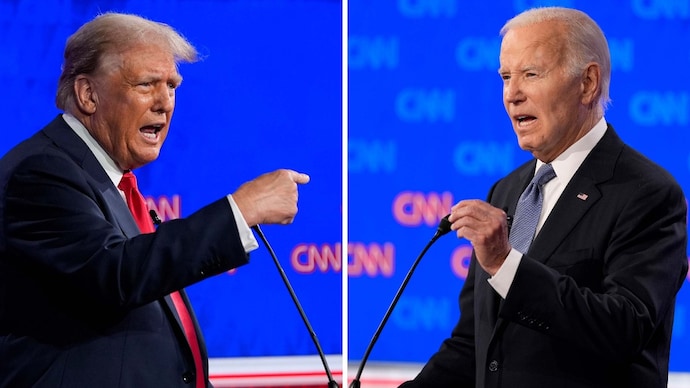Biden vs Trump: Whose Economic Plan Reigns #1?
The economic policies of Presidents Joe Biden and Donald Trump have been subjects of intense debate, each presenting distinct visions for America’s economic future. As we dissect the economic blueprints of both leaders, it’s crucial to understand their policies’ potential impact on the nation’s prosperity, job market, healthcare, infrastructure, and overall economic stability. This report delves into the economic plans of Biden and Trump, evaluating their effectiveness in addressing the critical economic issues facing the United States.
Introduction
The economic strategies of Joe Biden and Donald Trump reflect their broader political ideologies. Biden’s approach is rooted in progressive economic principles, emphasizing increased government spending, social welfare programs, and progressive taxation. In contrast, Trump’s economic blueprint centers on conservative economic tenets, advocating for tax cuts, deregulation, and limited government intervention in the free market.
Biden’s Economic Blueprint
Joe Biden’s economic plan is characterized by substantial government investment in infrastructure and green energy. This includes a proposed $2 trillion plan to rebuild the nation’s roads, bridges, and public transit systems, which aims to create millions of jobs, boost productivity, and stimulate long-term economic growth. A significant portion of this investment is dedicated to promoting green energy, aiming to combat climate change by transitioning away from fossil fuels and investing in renewable energy sources like solar and wind. This shift is projected to create new industries and job opportunities while reducing carbon emissions.
In the healthcare sector, Biden aims to strengthen the Affordable Care Act (ACA) by increasing subsidies to make healthcare more affordable for middle and low-income families. He also supports the introduction of a public health insurance option, allowing more Americans to access quality healthcare without the financial burden. Additionally, Biden’s plan includes measures to lower prescription drug costs, such as allowing Medicare to negotiate prices directly with pharmaceutical companies.
Biden’s economic blueprint also emphasizes education and workforce development as cornerstones for future economic growth. His plan proposes universal pre-kindergarten education and free community college tuition to enhance workforce skills and promote upward mobility. To address the evolving job market, Biden advocates for robust job training programs to equip workers with the necessary skills for high-demand industries.
In terms of tax policy, Biden focuses on increasing taxes on the wealthiest individuals and corporations. He proposes raising the corporate tax rate from 21% to 28% and increasing taxes on individuals earning over $400,000 annually. The additional revenue from these taxes would fund his ambitious spending programs, aimed at reducing economic inequality and providing greater economic security for middle and low-income families.
Biden’s plan also includes significant expansions of social welfare programs. This includes a notable expansion of the child tax credit, providing families with monthly payments to reduce child poverty. Additionally, his administration supports extending enhanced unemployment benefits to provide financial security for those affected by economic downturns.
Read More: Biden to Announce 2024 Immigration Policy Changes
Trump’s Economic Blueprint
Donald Trump’s economic blueprint, in contrast, is centered on tax cuts and deregulation. A cornerstone of Trump’s economic policy was the Tax Cuts and Jobs Act (TCJA) of 2017, which reduced the corporate tax rate from 35% to 21% and implemented significant tax cuts for individuals. Trump argues that these tax cuts stimulate economic growth by increasing disposable income and encouraging business investment.
Trump’s administration focused on rolling back regulations, particularly in the energy sector, to promote business growth and reduce compliance costs. The belief is that a less regulated economy fosters innovation and job creation.
In terms of trade policies, Trump’s “America First” trade policy aimed to renegotiate trade agreements to favor American workers and industries. The administration imposed tariffs on imported goods, particularly from China, aiming to reduce trade deficits and protect domestic manufacturing jobs. Trump renegotiated the North American Free Trade Agreement (NAFTA), resulting in the United States-Mexico-Canada Agreement (USMCA), which aimed to provide fairer terms for American workers and industries.
In the healthcare sector, Trump’s economic plan included efforts to repeal and replace the Affordable Care Act. Although unsuccessful, the administration supported measures to reduce healthcare costs through market-based reforms. Trump’s executive orders aimed at increasing transparency in drug pricing and reducing out-of-pocket costs for consumers.
In education and workforce development, Trump’s policies promoted school choice, advocating for policies that allow parents to use public funds for private or charter schools. His administration emphasized expanding apprenticeship programs and vocational training to provide alternative pathways to high-paying jobs. Trump’s economic blueprint included efforts to reform welfare programs by imposing work requirements and reducing dependency on government assistance. During the COVID-19 pandemic, the administration supported enhanced unemployment benefits, although with a focus on encouraging a swift return to work.
Comparative Analysis
Evaluating the economic plans of Biden and Trump involves examining their potential impacts on economic growth, job creation, healthcare, tax policy, trade policies, social welfare, and education. Biden’s approach relies heavily on government spending to stimulate economic growth. By investing in infrastructure, green energy, and education, the administration aims to create millions of jobs and boost long-term productivity. Critics argue that this approach could lead to increased national debt and inflation.
In contrast, Trump’s strategy centers on tax cuts and deregulation to stimulate economic growth. The TCJA aimed to increase disposable income for consumers and incentivize business investment. While this approach led to short-term economic growth, critics argue that it disproportionately benefited the wealthy and increased income inequality.
In the healthcare sector, Biden’s plan to expand the ACA and introduce a public health insurance option aims to increase healthcare access and affordability. Lowering prescription drug prices could provide significant financial relief for many Americans. However, the cost of these programs raises concerns about their long-term sustainability. In contrast, Trump’s efforts to repeal the ACA were aimed at reducing government involvement in healthcare. Market-based reforms and price transparency initiatives sought to lower costs, but the lack of a comprehensive replacement plan left many Americans uncertain about their healthcare future.
In terms of tax policy, Biden’s progressive taxation aims to address income inequality and fund social programs. By increasing taxes on the wealthy and corporations, Biden seeks to redistribute wealth and provide greater economic security for middle and low-income families. Critics argue that higher taxes could stifle business investment and economic growth. On the other hand, Trump’s tax cuts and deregulation are designed to stimulate economic growth by increasing disposable income and reducing business costs. While these measures led to economic expansion, they also contributed to rising income inequality and a larger federal deficit.
Biden’s trade policy maintains a tough stance on trade with China, focusing on fair trade practices and protecting American jobs. His administration seeks to rebuild alliances with traditional trade partners and promote multilateral agreements. Trump’s “America First” trade policy aimed to renegotiate trade deals to benefit American workers and industries. Tariffs and trade barriers sought to reduce trade deficits but also led to trade tensions and retaliatory measures from other countries.
In social welfare and education, Biden’s plan to expand social welfare programs and invest in education aims to reduce poverty and promote economic mobility. Universal pre-K, free community college, and job training programs seek to equip the workforce with the skills needed for a changing economy. In contrast, Trump’s welfare reform and school choice policies focus on reducing dependency on government assistance and promoting individual responsibility. Apprenticeships and vocational training programs provide alternative pathways to employment, but critics argue that these measures may not be sufficient to address systemic inequality.
Conclusion
Both Biden and Trump present distinct economic blueprints, each with its strengths and weaknesses. Biden’s approach emphasizes government intervention, social welfare, and progressive taxation to promote economic equity and long-term growth. In contrast, Trump’s strategy focuses on tax cuts, deregulation, and market-based reforms to stimulate short-term economic expansion and business investment.
Determining which economic plan reigns supreme depends on one’s perspective on the role of government in the economy, the importance of social welfare, and the best path to sustainable growth. Biden’s plan aims to address systemic inequality and invest in future growth through education and green energy, while Trump’s plan seeks to stimulate immediate economic activity through tax cuts and deregulation.
Ultimately, the effectiveness of either plan will be judged by its ability to navigate the complex economic challenges facing the United States, from healthcare and education to trade and infrastructure. As the nation moves forward, the ongoing debate between these two economic visions will continue to shape the future of the American economy.





